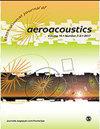Impedance models for single and two degree of freedom linings and correlation with grazing flow duct testing
IF 1.3
4区 工程技术
Q3 ACOUSTICS
引用次数: 2
Abstract
Presented here is the development of a predictive model for impedance of single-degree-of-freedom (SDOF) and two-degree-of-freedom (2DOF) acoustic linings that is suitable for the design stage of suppression of inlet noise for turbo-fan engines. It is required that over a probable range of lining physical parameters and operating conditions the impedance spectrum is predicted with accuracy sufficient to support a lining design process and assessment of achievable attenuation. The starting point is a published impedance model for SDOF linings that primarily focuses on the transfer impedance of conventional and micro-perforate face sheets with grazing flow. This is expanded here to include 2DOF linings, introducing new issues related to transfer impedance of the inserted septum. Problems addressed are related to the septum insertion process that can change thickness, hole diameter and open area ratio of the uninstalled septum, and introduce blockage. Required empiricism is discussed and models for face sheet and septum-in-core transfer impedance are derived, applicable to a specific range of sheet thickness, hole diameter, and open area ratio. Manufacturing processes considered are mechanical drilling in the case of the carbon fiber laminate face sheet that is conventional perforate, and laser drilling in the case of the epoxy film micro-perforate septum material. Benchmarking is carried out by comparison of acoustic field predictions, using the proposed lining model in an FEM propagation code, with measured data from a grazing flow duct facility. Test samples include SDOF and 2DOF linings, including cases with three segments, each with distinct physical properties. Example results of comparisons are shown to highlight the fidelity of the impedance model over a frequency range compatible with the grazing flow duct geometry.单自由度和二自由度衬里的阻抗模型及其与掠流管道测试的相关性
本文提出了一种适用于涡扇发动机进气噪声抑制设计阶段的单自由度和双自由度声学衬里阻抗预测模型。要求在衬里物理参数和工作条件的可能范围内,准确预测阻抗谱,以支持衬里设计过程和可实现衰减的评估。研究的出发点是已发布的SDOF衬板阻抗模型,该模型主要关注传统和微射孔面板在掠流作用下的传递阻抗。这里扩展到包括2DOF衬里,引入了与插入隔膜转移阻抗相关的新问题。所解决的问题与鼻中隔插入过程有关,该过程会改变未安装鼻中隔的厚度、孔径和开放面积比,并导致堵塞。讨论了所需的经验,并推导了适用于特定板厚、孔直径和开口面积比范围的面板和芯内隔膜传递阻抗模型。考虑的制造工艺有:传统穿孔的碳纤维层压板表面采用机械钻孔,环氧膜微穿孔隔膜材料采用激光钻孔。利用有限元传播程序中提出的衬砌模型,将声场预测与放牧管道设施的实测数据进行比较,从而进行基准测试。测试样品包括SDOF和2DOF衬里,包括三段衬里,每段都有不同的物理特性。对比的示例结果显示,在与掠流管道几何形状兼容的频率范围内,阻抗模型的保真度突出。
本文章由计算机程序翻译,如有差异,请以英文原文为准。
求助全文
约1分钟内获得全文
求助全文
来源期刊

International Journal of Aeroacoustics
ACOUSTICS-ENGINEERING, AEROSPACE
CiteScore
2.10
自引率
10.00%
发文量
38
审稿时长
>12 weeks
期刊介绍:
International Journal of Aeroacoustics is a peer-reviewed journal publishing developments in all areas of fundamental and applied aeroacoustics. Fundamental topics include advances in understanding aeroacoustics phenomena; applied topics include all aspects of civil and military aircraft, automobile and high speed train aeroacoustics, and the impact of acoustics on structures. As well as original contributions, state of the art reviews and surveys will be published.
Subtopics include, among others, jet mixing noise; screech tones; broadband shock associated noise and methods for suppression; the near-ground acoustic environment of Short Take-Off and Vertical Landing (STOVL) aircraft; weapons bay aeroacoustics, cavity acoustics, closed-loop feedback control of aeroacoustic phenomena; computational aeroacoustics including high fidelity numerical simulations, and analytical acoustics.
 求助内容:
求助内容: 应助结果提醒方式:
应助结果提醒方式:


